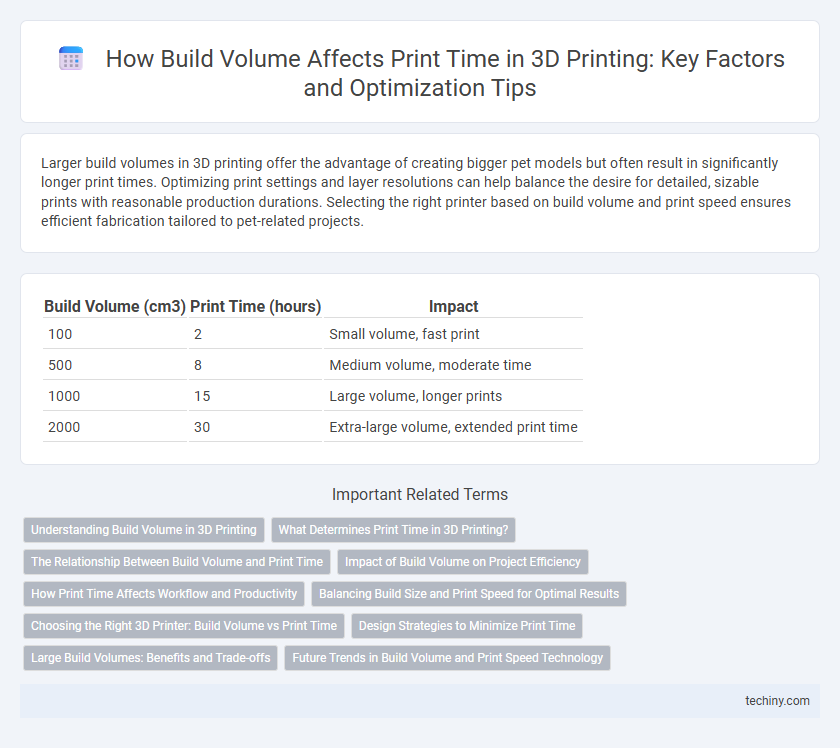Larger build volumes in 3D printing offer the advantage of creating bigger pet models but often result in significantly longer print times. Optimizing print settings and layer resolutions can help balance the desire for detailed, sizable prints with reasonable production durations. Selecting the right printer based on build volume and print speed ensures efficient fabrication tailored to pet-related projects.
Table of Comparison
| Build Volume (cm3) | Print Time (hours) | Impact |
|---|---|---|
| 100 | 2 | Small volume, fast print |
| 500 | 8 | Medium volume, moderate time |
| 1000 | 15 | Large volume, longer prints |
| 2000 | 30 | Extra-large volume, extended print time |
Understanding Build Volume in 3D Printing
Build volume in 3D printing defines the maximum size of an object that can be printed within the printer's build area, typically measured in cubic millimeters or inches. Larger build volumes enable the production of bigger or multiple parts in a single print, but often increase print time due to the greater amount of material deposited and printer head movement required. Optimizing build volume relative to print time is essential for efficient production workflows and cost-effective prototyping.
What Determines Print Time in 3D Printing?
Print time in 3D printing is primarily determined by the build volume, layer height, and print speed settings of the printer. Larger build volumes require more time as the printer deposits material layer by layer, while finer layer heights increase precision but extend the duration. Print complexity and the type of material used also significantly influence the overall print time.
The Relationship Between Build Volume and Print Time
Build volume directly impacts print time in 3D printing, as larger build volumes require more material deposition and extended layer-by-layer processing. Print time scales proportionally with the Z-axis height and the total volume of the object being printed, making optimization crucial for efficiency. Balancing build volume and print speed is essential for managing production timelines and resource consumption in additive manufacturing.
Impact of Build Volume on Project Efficiency
Larger build volumes in 3D printing increase project capacity by enabling multiple parts to be printed simultaneously, thereby reducing overall production time. However, expanded build volume often results in longer print durations per job due to the need for extended layer deposition and cooling times. Optimizing build volume relative to print time is essential for maximizing efficiency in additive manufacturing workflows.
How Print Time Affects Workflow and Productivity
Larger build volumes in 3D printing significantly increase print times, directly impacting workflow efficiency and overall productivity. Extended print durations limit the number of parts produced within tight deadlines, slowing design iteration and project completion. Optimizing print settings and balancing build volume with achievable print times enhances throughput and accelerates development cycles.
Balancing Build Size and Print Speed for Optimal Results
Balancing build volume and print time is crucial in 3D printing to achieve optimal results, as larger build sizes significantly increase print duration due to layer-by-layer construction. Selecting an appropriate build volume based on project requirements ensures efficient use of printer capabilities without compromising speed or detail quality. Optimizing print parameters such as layer height and infill density further harmonizes build size with acceptable print times, enhancing overall productivity.
Choosing the Right 3D Printer: Build Volume vs Print Time
Selecting the right 3D printer requires balancing build volume and print time to meet project demands efficiently. Larger build volumes accommodate bigger or multiple parts but extend print durations, impacting productivity and resource usage. Prioritize printers with optimized layer resolution and print speed settings to achieve the best trade-off between volume capacity and time efficiency for your specific applications.
Design Strategies to Minimize Print Time
Optimizing build volume utilization directly impacts print time by reducing unnecessary material deposition and movement. Employing design strategies such as hollowing models, using infill patterns with lower density, and segmenting large prints into smaller parts decreases print duration while maintaining structural integrity. Strategic orientation on the print bed minimizes support structures, further enhancing efficiency and shortening overall print time.
Large Build Volumes: Benefits and Trade-offs
Large build volumes in 3D printing enable the production of bigger, more complex parts without the need for assembly, significantly broadening design possibilities and applications in industries such as aerospace and automotive. However, increased build volume typically leads to longer print times and higher material consumption, impacting overall production efficiency and cost. Balancing build volume with optimized slicing settings and print speed is crucial to maximize productivity while maintaining part quality in large-scale additive manufacturing.
Future Trends in Build Volume and Print Speed Technology
Advancements in 3D printing technology are driving significant increases in build volume, enabling the production of larger and more complex objects without sacrificing precision. Concurrently, innovations in print speed, such as multi-laser systems and improved material deposition methods, are drastically reducing print times while maintaining high-quality outputs. Future trends indicate a convergence of expanded build volumes with accelerated print speeds, enhancing the scalability and efficiency of additive manufacturing across industries.
Build Volume vs Print Time Infographic

 techiny.com
techiny.com